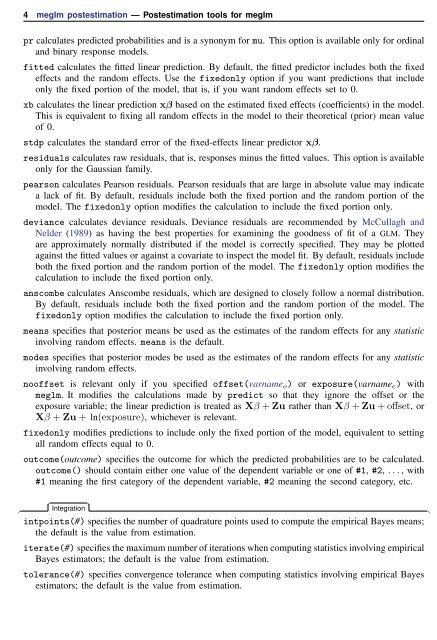meglm postestimation - Stata
meglm postestimation - Stata
meglm postestimation - Stata
You also want an ePaper? Increase the reach of your titles
YUMPU automatically turns print PDFs into web optimized ePapers that Google loves.
4 <strong>meglm</strong> <strong>postestimation</strong> — Postestimation tools for <strong>meglm</strong><br />
✄<br />
pr calculates predicted probabilities and is a synonym for mu. This option is available only for ordinal<br />
and binary response models.<br />
fitted calculates the fitted linear prediction. By default, the fitted predictor includes both the fixed<br />
effects and the random effects. Use the fixedonly option if you want predictions that include<br />
only the fixed portion of the model, that is, if you want random effects set to 0.<br />
xb calculates the linear prediction xβ based on the estimated fixed effects (coefficients) in the model.<br />
This is equivalent to fixing all random effects in the model to their theoretical (prior) mean value<br />
of 0.<br />
stdp calculates the standard error of the fixed-effects linear predictor xβ.<br />
residuals calculates raw residuals, that is, responses minus the fitted values. This option is available<br />
only for the Gaussian family.<br />
pearson calculates Pearson residuals. Pearson residuals that are large in absolute value may indicate<br />
a lack of fit. By default, residuals include both the fixed portion and the random portion of the<br />
model. The fixedonly option modifies the calculation to include the fixed portion only.<br />
deviance calculates deviance residuals. Deviance residuals are recommended by McCullagh and<br />
Nelder (1989) as having the best properties for examining the goodness of fit of a GLM. They<br />
are approximately normally distributed if the model is correctly specified. They may be plotted<br />
against the fitted values or against a covariate to inspect the model fit. By default, residuals include<br />
both the fixed portion and the random portion of the model. The fixedonly option modifies the<br />
calculation to include the fixed portion only.<br />
anscombe calculates Anscombe residuals, which are designed to closely follow a normal distribution.<br />
By default, residuals include both the fixed portion and the random portion of the model. The<br />
fixedonly option modifies the calculation to include the fixed portion only.<br />
means specifies that posterior means be used as the estimates of the random effects for any statistic<br />
involving random effects. means is the default.<br />
modes specifies that posterior modes be used as the estimates of the random effects for any statistic<br />
involving random effects.<br />
nooffset is relevant only if you specified offset(varname o ) or exposure(varname e ) with<br />
<strong>meglm</strong>. It modifies the calculations made by predict so that they ignore the offset or the<br />
exposure variable; the linear prediction is treated as Xβ + Zu rather than Xβ + Zu + offset, or<br />
Xβ + Zu + ln(exposure), whichever is relevant.<br />
fixedonly modifies predictions to include only the fixed portion of the model, equivalent to setting<br />
all random effects equal to 0.<br />
outcome(outcome) specifies the outcome for which the predicted probabilities are to be calculated.<br />
outcome() should contain either one value of the dependent variable or one of #1, #2, . . . , with<br />
#1 meaning the first category of the dependent variable, #2 meaning the second category, etc.<br />
✄<br />
Integration<br />
<br />
intpoints(#) specifies the number of quadrature points used to compute the empirical Bayes means;<br />
the default is the value from estimation.<br />
iterate(#) specifies the maximum number of iterations when computing statistics involving empirical<br />
Bayes estimators; the default is the value from estimation.<br />
tolerance(#) specifies convergence tolerance when computing statistics involving empirical Bayes<br />
estimators; the default is the value from estimation.
















